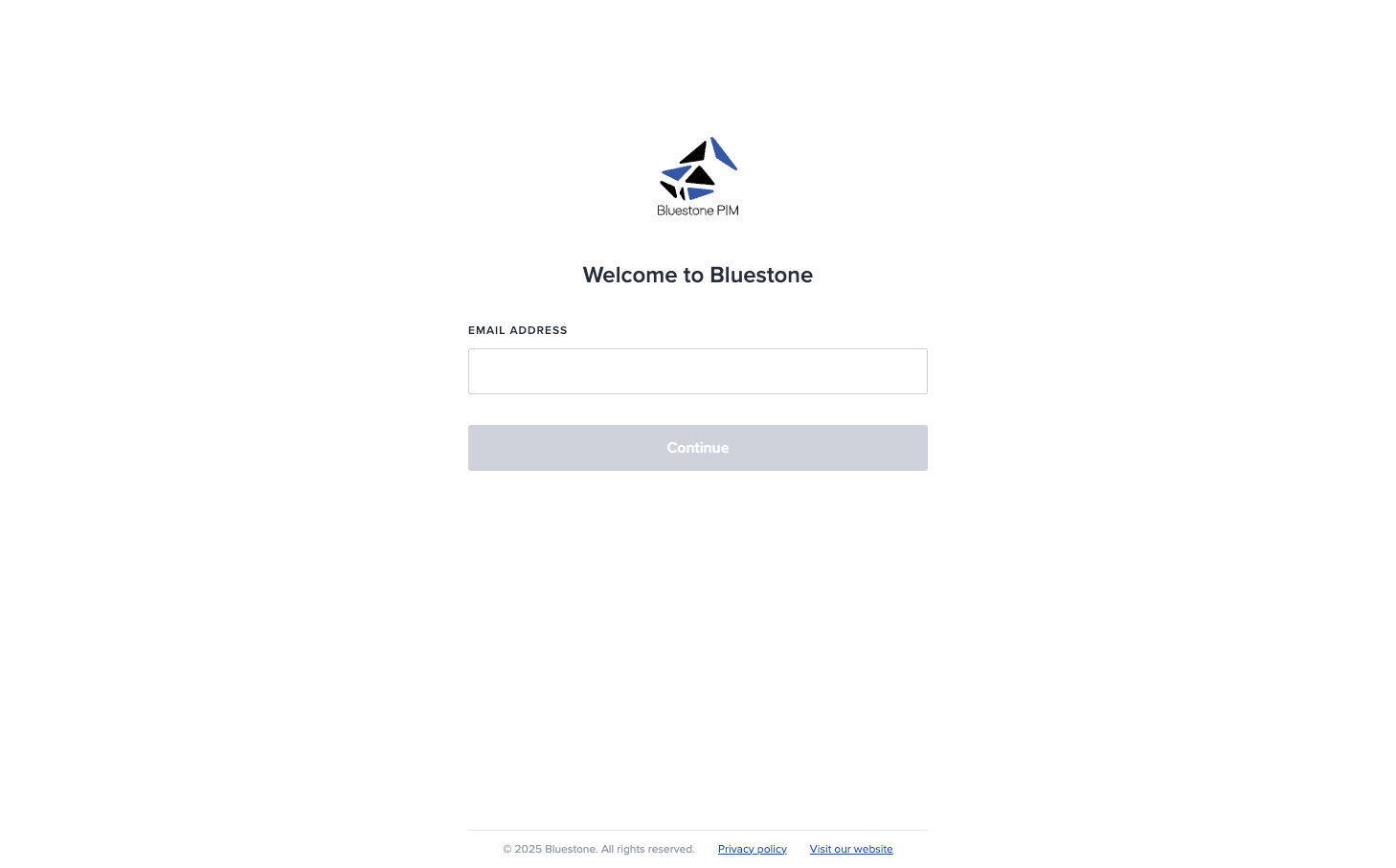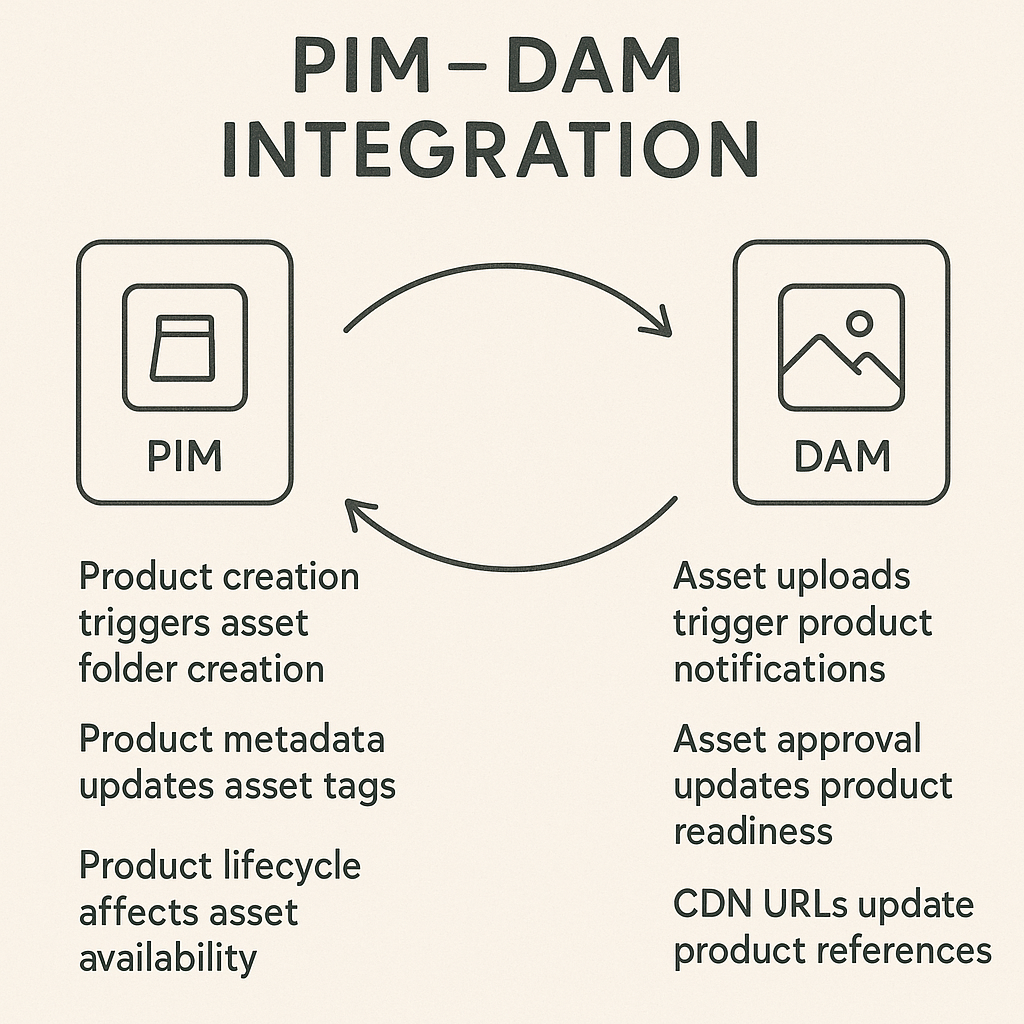Platform Overview
Bluestone follows a MACH-aligned, micro-service approach where each tenant is provisioned as an isolated set of services. The platform represents modern composable commerce architecture with cloud-native design principles and micro-services implementation.
The platform stores attribute values as JSON documents with locale and channel dimensions, using Elasticsearch for flattened search indexing. This modern architecture enables flexible data modeling while maintaining high performance for complex product catalogs.
Key Facts
- Founded: 2010s
- Headquarters: Norway
- Architecture: MACH-aligned micro-services
- Infrastructure: AWS cloud-native
- API: REST with comprehensive filtering and webhooks

Bluestone PIM Login Interface
Clean and modern login interface showcasing Bluestone's enterprise-grade authentication system with email-based access.
Core entities in Bluestone's micro-services based data model with flexible JSON document storage
| Entity | Vendor Name | Description | Key Attributes | Relationships |
|---|---|---|---|---|
Product | Product | Primary SKU record that can reference multiple Variants with JSON document storage | json_attributes locale_dimensions channel_scope external_id | references Variants belongs to Catalogs linked to Assets |
Variant Group | Variant Group (Master) | Master product containing Variant Level Attributes (VLAs) shared across child variants | variant_level_attributes shared_properties inheritance_rules | parent of Variants defines shared attributes linked to Assets |
Variant | Variant | Specific sellable instance that inherits from Variant Group but can override values and have unique attributes | inherited_attributes override_values variant_specific_attributes | child of Variant Group can override inherited values supports unique attributes |
Task | Task | Hardcoded workflow entity for process management, separate from the flexible data model | workflow_state assignee due_date approval_status | linked to Products/Variants part of workflow automation not customizable entity type |
Attribute | Attribute | Metadata field with types including text, number, boolean, date, media, reference | data_type validation_rules locale_support channel_scope | grouped in Attribute Groups used by Products/Variants can be Variant Level Attributes |
Attribute Group | Attribute Group | UI grouping and permission context for organizing related attributes | group_name display_order permissions | contains Attributes defines UI layout |
Catalog | Catalog | Logical assortment (channel) with rules for completeness, attributes and structure | channel_config completeness_rules attribute_mapping | contains Categories scopes Products defines Channel rules |
Asset | Asset | Media file stored in DAM micro-service with on-the-fly rendition generation | file_data metadata renditions cdn_urls | linked to Products/Variants organized in folder structure |
New to PIM systems?
Before diving into Bluestone specifics, you might want to read our detailed guide to PIM systems to understand the fundamentals and key concepts.
Read PIM Systems GuideComplete list of attribute types available in Bluestone with their micro-services implementation
| Common Name | Vendor Name | Description | Operators | Examples |
|---|---|---|---|---|
Text | text_short, text_long, markdown | Text fields with varying length and markdown formatting support | eq neq contains startsWith endsWith isEmpty isNotEmpty | Product name Description SKU |
Number | number_integer, number_decimal | Numeric fields for integers and decimal values | eq neq gt gte lt lte between | Price Weight Quantity |
Boolean | boolean | True/false field | true false | Is active Featured Discontinued |
Date | date, datetime | Date and datetime fields | before after between | Launch date Last modified Expiry date |
Single Select | list_single | Single option from predefined option set | eq neq in nin isEmpty isNotEmpty | Brand Category Status |
Multi Select | list_multi | Multiple options from predefined option set | in nin containsAny containsAll | Features Materials Certifications |
Rich Text | rich_text_html | HTML rich text editor for formatted content | contains isEmpty isNotEmpty | Product description Marketing copy Instructions |
Entity Reference | reference_product, reference_variant, reference_catalog | References to other entities within the system | eq neq in nin isEmpty isNotEmpty | Related products Category references Variant links |
Complex Object | json | Flexible JSON field for complex structured data | isEmpty isNotEmpty | Technical specifications Configuration data Structured metadata |
API Implementation Details
MACH Architecture
Fully cloud-native AWS deployment with multi-region clusters (EU, US, APAC). Each tenant is provisioned as isolated micro-services, ensuring security and scalability while enabling independent service updates.
API Authentication & Rate Limiting
API keys scoped per service with default rate limit of 500 requests/minute. The micro-services architecture allows fine-grained access control and independent scaling of different platform components.
Advanced Filtering & Search
REST endpoints accept query parameters or JSON body filters with comprehensive operators per data type. Elasticsearch-powered search provides faceted filtering and full-text search capabilities across all product attributes.
"Bluestone's managed approach to API access and deployment ensures exceptional platform stability and consistency. The structured deployment process for Package Business Capabilities (PBCs) demonstrates their commitment to maintaining a high-quality, enterprise-grade environment. For organizations needing more flexibility, the 'master API access' option combined with API management proxy solutions provides an excellent balance of control and governance."
Workflow Automation & Publishing
Configurable workflows can automatically create tasks when products are created, with approval processes for AI-generated content. Launch dates can trigger automatic data publishing to external systems. Organizations can choose whether the PIM triggers publishing events or if external e-commerce systems execute the publishing based on PIM data.
Webhooks & Real-time Events
Any entity change can trigger POST to external URLs with HMAC signature verification. This enables real-time integration patterns and event-driven architectures for both workflow automation and data synchronization.
Extension Hub
Micro-service plug-ins deployed via Extension Hub including AI Translator, Shopify connector, and custom integrations. This extensibility model supports composable commerce requirements and custom workflow implementations.
API Usage Example
Example showing how to upsert a product using Bluestone's REST API
# Upsert a product title in Bluestone PIM
TOKEN="<api_key>"
BASE="https://api-eu.bluestonepim.com/v2"
curl -X PATCH "$BASE/products" \
-H "x-api-key: $TOKEN" \
-H "Content-Type: application/json" \
-d '[{
"externalId": "SKU-12345",
"attributes": {
"name": {
"en": "New product name 2025"
}
}
}]'Technical Specifications
MACH Architecture
Bluestone follows MACH Alliance principles, demonstrating commitment to Microservices, API-first, Cloud-native, and Headless architecture principles with modern composable commerce implementation.
Built-in DAM Micro-service
Integrated digital asset management with Amazon S3 storage and CloudFront CDN. Auto-generated renditions (JPEG, WebP, AVIF) with AI enrichment via Azure Vision plug-in.
Rights Management & External Data Sources
Attributes can be configured with source set to "External" to prevent manual editing in the PIM UI while allowing exclusive updates via API calls from external systems. This is ideal for ERP-controlled data like purchasing prices that need to be displayed and used in PIM workflows without risking data integrity through manual edits.
Workflow Automation & Tasks
Tasks are hardcoded entities for workflow management, separate from the flexible product data model. Automatic workflows can be configured to create tasks when products are created, with approval processes for AI-generated content and scheduled publishing dates. Launch dates can trigger automatic data publishing to external systems.
Variant Inheritance Model
Variant groups (masters) use Variant Level Attributes (VLAs) for common data shared across variants. Variants can override inherited values when configured to allow it, and support variant-specific attributes that don't exist on the master level. This provides flexibility for managing both shared and unique data efficiently.
Custom Entity Modeling
For custom business objects like materials or components, the recommended approach is modeling them as product types within the flexible data model rather than expecting hardcoded entity types. The platform supports singles, bundles, variant groups, and variants with configurable attributes and relationships.
Enrichment Insights
Configurable dashboards showing completeness percentages, attribute fill rates, and workflow SLA tracking. Insight widgets provide threshold-based traffic-light status indicators.
Strategic considerations for Bluestone implementation including MACH architecture benefits, composable commerce, and platform decisions
Limitations & Implementation Considerations
API Permission Complexity
Different API endpoints have varying permission requirements that may not be immediately apparent. While Elasticsearch search endpoints typically work with basic MAPI credentials, detailed product management endpoints often require higher permission levels. This can create unexpected access limitations during implementation.
JSON Document Architecture Learning Curve
The JSON document storage approach handles locale and channel dimensions differently than traditional attribute-table structures. Teams familiar with relational PIM architectures need time to adapt to the document-based data modeling patterns.
Rate Limiting & Tenant Isolation
Each tenant gets isolated microservice instances with 500 requests/minute API rate limits. While this provides security benefits, it can impact integration patterns that require high-frequency API calls or real-time synchronization scenarios.
MACH Architecture Investment
The microservices architecture and Extension Hub capabilities require technical expertise to fully leverage. Organizations without composable commerce strategies may not realize the full value of the MACH-certified platform investment.
Variant Level Attributes Complexity
While VLAs provide powerful inheritance capabilities, the override mechanisms and variant-specific attribute management can become complex for teams managing large product catalogs with deep variant hierarchies.
Bluestone's MACH certification and microservices architecture require specialized contract negotiations that balance platform flexibility with cost predictability.
Key Benefits & Strengths
MACH-Aligned Architecture
Bluestone follows MACH Alliance principles, ensuring true microservices, API-first, cloud-native, and headless architecture. This enables composable commerce strategies and future-proof technology investments.
Flexible Variant Inheritance
Variant groups (masters) use Variant Level Attributes (VLAs) for shared data across variants, while variants can override inherited values and support unique attributes not present on the master. This provides efficient management of both common and variant-specific data for complex product lines.
Advanced Workflow Automation
Configurable workflows automatically create tasks for product enrichment, with approval processes for AI-generated content and scheduled publishing. Organizations can choose whether the PIM triggers publishing events or external systems execute based on PIM data.
Cloud-Native Performance
AWS-based infrastructure with multi-region deployment (EU, US, APAC) and isolated tenant provisioning. Elasticsearch-powered search provides high-performance filtering and faceted search capabilities.
Extensible Micro-services
Extension Hub enables deployment of custom micro-service plug-ins including AI translators, channel connectors, and business logic extensions. This supports evolving business requirements without platform limitations.
Real-time Integration
Comprehensive webhook system with HMAC signatures enables real-time event-driven integrations. API-first design supports headless commerce and omnichannel distribution strategies.
Built-in DAM Integration
Native digital asset management micro-service with automatic rendition generation, CDN delivery, and AI-powered metadata enrichment. Eliminates need for separate DAM solutions.
Customer Review
Sivert Kjøller Bertelsen
PIM Implementation Consultant • Bluestone evaluation experience
"Bluestone delivers genuine MACH architecture with impressive AWS multi-region deployment capabilities. The Extension Hub opens up exciting possibilities for custom microservice plugins, leveraging modern JSON document structures for maximum flexibility. Each tenant benefits from dedicated infrastructure, providing enterprise-level security and consistent API performance that scales with your needs."



